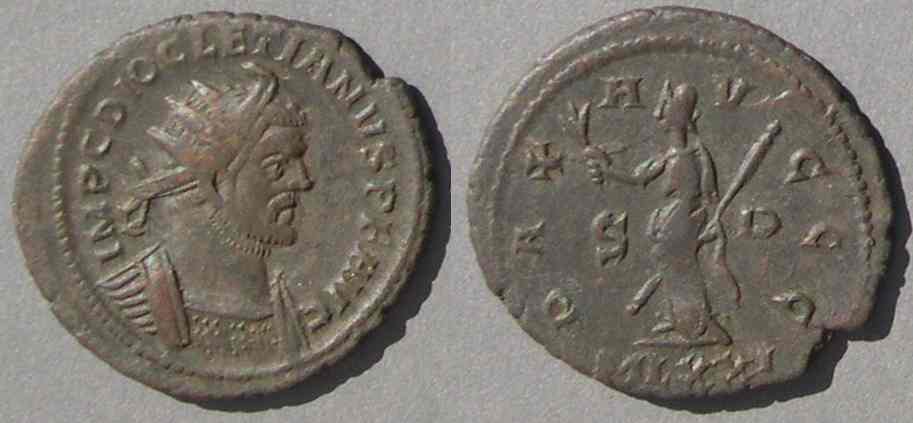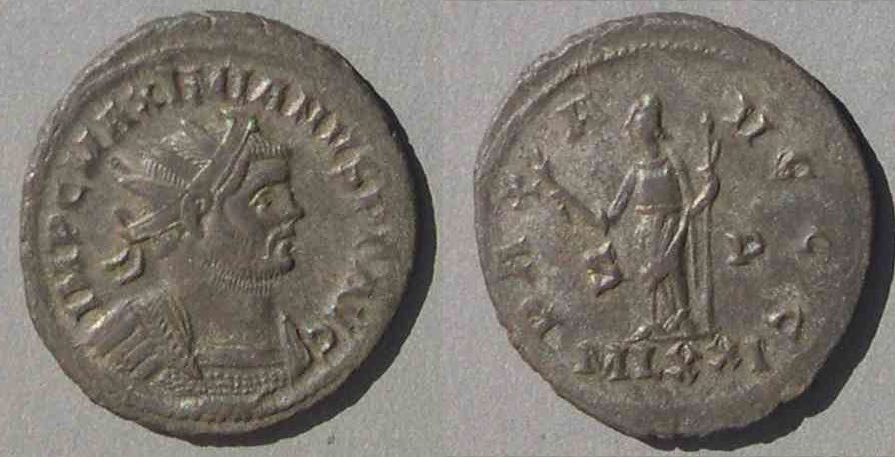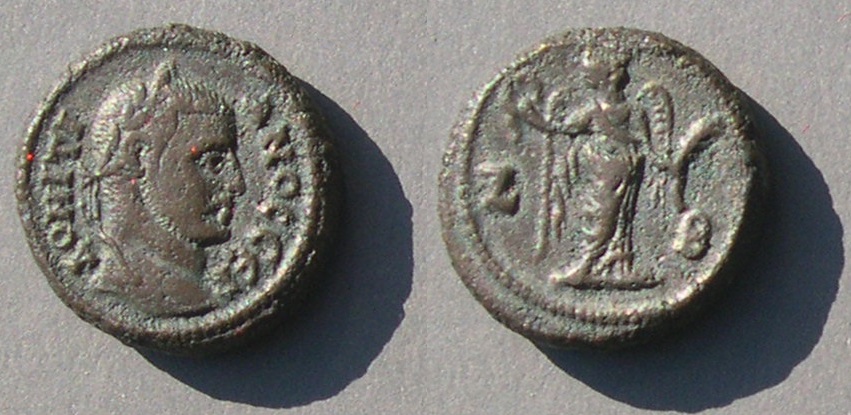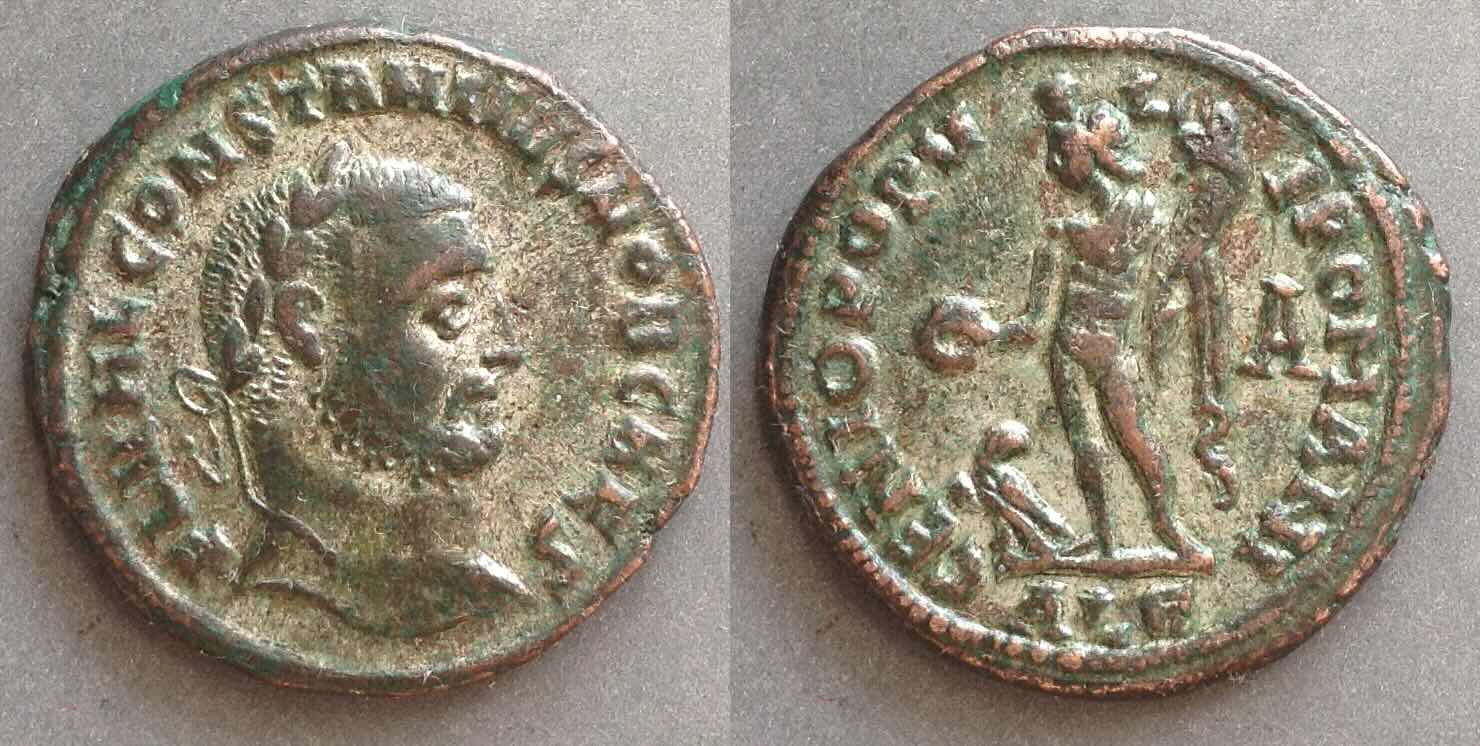Roman imperial usurpers who wanted to join the club
This page discusses two Roman usurpers who issued coins, not only in their own names, but also in the names of the regular rulers.
Roman usurpers usually wanted to replace the current emperor and become sole emperor. They publicized their revolts with issues of coins with their own portraits and names and usually did not also include the names of the regular emperors. However, under Diocletian and Maximian there were two rebellions (of Carausius in Britain and of Domitius Domitianus in Egypt) in which the usurpers were unable to expand their original territories but hoped to hold onto them, so they appealed for recognition as co-emperors. The peace offerings were joint issues in the names of all the rulers, but they did not result in reciprocal recognition. The regions were reconquered by Constantius and Diocletian.
What's new? 2025, May 31: A year-12 Alexandrian tetradrachm of Diocletian relevant to dating the usurpation of Domitius Domitianus.
2025, Feb. 22: A coin of Constantius issued by Domitius Domitianus.
Coins of the usurper Carausius.
Carausius issued a large and varied coinage with only a small fraction of it also struck in the names of Diocletian and Maximian.
Carausius revolted in Gaul in 287 but soon retreated to Britain, which he held for seven years until he was assassinated by Allectus, who ruled the "British Empire" until 296. Carausius issued many coin types, including "PAX AVG" in his own name with only one "G", asserting his claim to become sole emperor. Later, when that hope faded, he issued the type with "PAX AVGGG", with the three Gs recognizing three emperors, which signaled he wanted to be accepted as co-emperor with control of Britain. It didn't happen.

Carausius
22 mm. 4.39 grams. 12:00.
IMP C CARAVSIVS PF AVG
PAX AVGGG
MLXXI
S P either side of Pax standing left holding olive branch and vertical scepter.
RIC V.II Carausius, 141c, London mint, "R", page 476.
(To see larger images, click the images.)

Diocletian
24-22 mm. 4.31 grams. 6:00.
IMP C DIOCLETIANVS PF AVG
[Note the perfectly parallel obverse legends]
PAX AVGGG
S P either side of Pax standing left holding olive branch and diagonal scepter.
RIC V.II Carausius, Diocletian, and Maximian, 6 "R" page 551.
 Maximian
Maximian
24-22 mm. 4.55 grams. 6:00.
IMP C MAXIMIANVS PF AVG
MLXXI
S P either side of Pax standing left holding olive branch and vertical scepter.
RIC V.II Carausius, Diocletian, and Maximian, 34 "R" page 555.
Carausius was assassinated in 293 by Allectus who reigned in Britain until 296 when he was defeated and killed by Constantius I from the central empire, which by that time had four rulers (the "First Tetrarchy").
The coins above are radiates, sometimes called "aureliani" (after Aurelian, who reformed this denomination) or "antoniniani" (after the real name of Caracalla who introduced the denomination. We don't know the ancient name of this denomination.). They were issued before the reform of Diocletian c. 294 which introduced the larger "follis" (aka "nummis") and the "radiate fraction" and discontinued the aurelianus.
The second usurper was L. Domitius Domitianus c. 296/7 in Egypt.
Domitius Domitianus minted a small issue of folles, all of them from Alexandria, Egypt, and all of them of the very common GENIO POPVLI ROMANI design. The one minor identifying difference from the usual issue is the addition of an eagle at the feet of Jupiter. The folles were struck in his name and the names of Diocletian and Maximian and their Caesars, Constantius and Galerius.

Domitius Domitianus
27 mm. 10.01 grams.
IMP C L DOMITVS DOMITIANVS AVG
laureate head right
GENIO POPVLI ROMANI
Genius standing left holding patera and cornucopia
eagle at feet left and B in field right
ALE = Alexandria mint, in exergue
RIC VI Alexandria 20, page 663
The dates of his reign are not certain. The primary evidence is from his Egyptian-style coins.

Domitius Domitianus
18 mm. 7.94 grams. 12:00
L B = year 2.
ΔOMITIANOC CEB
Victory standing, holding wreath and palm
Minted at Alexandria, Egypt
This is one of three Egyptian-style denominations he issued. There is one larger than this and one smaller. This size is a lot like the issues of Diocletian and Maximian, so it might be a "tetradrachm," making the larger denomination an "octodrachm" (8-drachm) and the smaller one a "didrachm" (2-drachm). Some think the larger denomination is a tetradrachm, just larger than the previous tetradrachms. Ancient testimony does not help us decide.
All his coins with dates say "LB" which means year 2. None say year 1 or year 3. This leads us to believe his revolt began so late in the Egyptian year that the mint did not have time to issue "year 1" types. In Roman times the Egyptian year ended August 28, so we think his reign began shortly before then. But which year?
The year is the subject of much dispute. It is clearly near the time of Diocletian's coin reform which introduced the follis denomination and replaced the tetradrachm denomination. But questions remain. Did Domitius Domitianus issue both types simultaneously? Was the reform already under way and he restored, with a wider range of denominations, the previous Egyptian-style coins? Were the Egyptian-style coins all issued before the "Latin" folles? And, if there is evidence in favor of any of these options, what was the year of the empire-wide follis reform anyway? I'm sure scholars will continue to have fun debating his dates for decades.
All the Egyptian-style coins of Domitius Domitianus are very rare--rarer than the imperial folles. They are very expensive, but less expensive than imperial coins because most collectors prefer imperial coins.
Evidence for the dates of Domitius Domitianus includes the dated coins of Diocletian and Maximian from Alexandria. Here is one of Diocletian from the last year of his Alexandrian coins, year 12, which was August 29, 296 to August 28, 297.
 Diocletian, year 12
Diocletian, year 12
20-19 mm. 7.36 grams. 12:00.
ΔIOKΛHTI-ANOC CЄB
Head right, laureate, draped, and cuirassed.
Elpis (Spes) advancing left holding flower and lifting up skirt
palm branch at lower left
L to left and IB to right.
Emmett 4046 year 12, rarity 1, which means very common, page 208.
His folles in the names of Diocletian, Maximian, Constantius, and Galerius show that we cannot simply assume that Domitius Domitianus discontinued tetradrachms of Diocletian and Maximian when he began his own issues. Maybe, for a while he coined for them, too. However, if he did replace Diocletian's tetradrachms with his own Egyptian-style coins, we would put year 1 of Domitius Domitianus sometime in year 12 of Diocletian. The fact that year 12 tetradrachms of Diocletian are common suggests Diocletian coined for most of the year, which fits with the lack of year 1 Alexandrian-style coins of Domitius Domitianus. If this were the only evidence, we would date Domitius Domitianus from c. August 297 to summer 298.
References:
Carson, R. A. G. "Carausius et Fratres Sui: A Reconsideration" in Studio Paulo Naster Oblata I Numismatica Antiqua, pages 245-258 and plates XXIX-XXXI, 1982. [See Shiel, below]
Casey, P. J. The British Usurpers Carausius & Allectus. 1994. Hardcover. 213 pages. 52 coins and some artifacts illustrated, with maps and charts. (A scholarly biography, with many coins discussed)
King, Cathy. review of L. Domitius Domitianus: Etude Numismatique et Papyrolgique by J. Schwartz, in JRS 67, 1977, page 209
Lallemand, Jacqueline. "The coinage of Domitius Domitianus," in Revue Belge de Numismatique, 1951, pp. 89-103 and plate VI, extended translation by Dane "Helvetica" Kurth. (This is a die study. Of course, very many new examples have been published since then.)
Metcalf, William E. "From Greek to Latin Currency in Third-century Egypt," in MdN in Honor of Peirre Bastien, 1987, pages 157-168.
Shiel, N. "Carausius et Fratres Sui", in BJN 48, 1978, pages 7-11.
Sutherland, C. H. V. "Diocletian's extension of the 'Latin' follis to Egypt: The date and sequence of issues," in Congresso Int. di Numismatia, volume 2, Rome, 1961, pages 341-346.
Weder, Marcus. "Römische Münzen und Münzstätten des 3. Jahrhundrets, IX" in SM 37, 1987. (An article in German about the transition from tetradrachm to follis at Alexandria.)
Roman Imperial Coinage volume V.II (for Carausius) by Mattingly and Sydenham
Roman Imperial Coinage volume VI (for Domitius Domitianus) by Sutherland
Note: RIC VI (p. 649ff) notes a very similar issue from Alexandria of GENIO POPVLI ROMANI with eagle that has, in additon, a star in the left field for Diocletian and Maximian, but no such examples are recorded for Domitius Domitianus. They infer that the issue with the eagle and star was issued after Alexandria was reconquered by the central empire.
Return to the main index page.





 Constantius, Caesar
Constantius, Caesar
